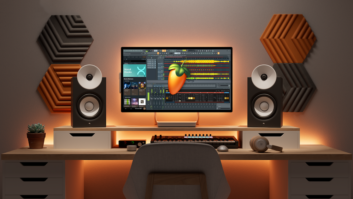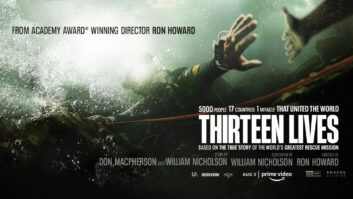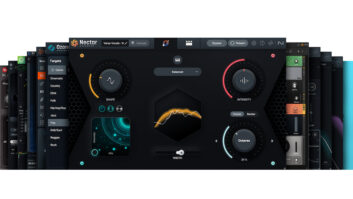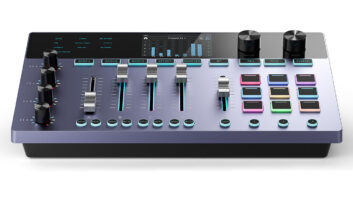The term “Sound Card” has become a bit of a misnomer. It once referred to a generic piece of consumer-oriented hardware designed to give computers a “voice.” The converters were cheesy, MIDI sounds were limited (on many models) and the DSP power was minimal. That was a long time ago-in computer years-when turnkey workstations cost tens of thousands of dollars and the heart of a professional sound card was, and still is, a hardware-dedicated Digital Signal Processor. In addition, an onboard hard disk controller made workstations like Sonic Solutions, Pro Tools and SADiE viable back in the day before microprocessors and disk drives attained today’s warp speed.
A` LA CARTEThat was then, “native” is now. Writing DSP-specific code is not as cost-effective as using generic code that takes advantage of the horsepower available in the latest microprocessors. Going native allows users to create an affordable workstation `a la carte; users can now choose hardware specific to their needs but not limited to any one software interface.
The products covered in this article-ADAT Edit, CM Automation’s Motor Mix controller, Minnetonka’s MxTrax (new Native version) and Syntrillium’s Cool Edit Pro-are just a few of the new breed of workstation options and accessories. These software products rely on minimal internal hardware, a PCI “I/O card” that is, more often than not, a simple digital interface-with no dedicated DSP. Onboard analog converters are the exception.
Minimal components on the I/O card make it more affordable to manufacture than its DSP counterpart-see Fig.1 for a hardware comparison-it’s so basic that it is less likely to become extinct. The money is in the “break-out box,” where you’ll find analog I/O (a moving target in terms of “bits” and sample rates), digital I/O (also a variable), plus the kitchen “Sync” of timing and control-word clock, video sync, timecode, MIDI, etc.
ME, MICE ELF, EYEOkay, fifth paragraph and you’re still with me. They say you can only write what you know, so here’s my story. For several years I have been using the same workstation-the Soundscape HDR-1 PLUS-a dedicated piece of hardware that has been extremely reliable and robust, requiring minimal resources from an aged PC, a Pentium 166. I have two accelerated units capable of mixing 24 tracks to stereo and 5.1 surround.
Soundscape shielded me from the world of sound cards until last year when I reviewed Mixtreme, the company’s entry into the sound-card arena. Like Yamaha’s DSP Factory, Mixtreme has onboard DSP and its “mixer” is identical to that of the workstation. But in order to capture and manipulate audio via hard disk, I had to learn new editing software, and if that weren’t enough, I also had to learn to configure the computer for more audio than just “You’ve Got Mail.” It was at this time that I was introduced to Sonic Foundry’s Acid and to Syntrillium’s Cool Edit Pro.
AH, SOFTWARE!Each time computers become more powerful, new software comes along to take advantage of that. We all want more tracks with lots of effects and no glitches, right? Native software is basically a recording, editing and mix “engine” that relies on your computer’s horsepower to deliver the goods. The audio engine may be a stand-alone product or it may also be integrated with a MIDI sequencer. Software that makes the host processor do DSP chores is no longer “married” to a specific hardware interface, assuming there is a standard among manufacturers.
ASIO (Audio Stream Input Output) drivers interface the software with the compatible hardware, thereby opening up a whole range of `a la carte options so users can mix and match according to their working style, interface needs and/or budget. ASIO drivers are more efficient than the MacOS Sound Manager or Windows Sound Drivers (Wave API and Direct Sound) and allow direct access to the card’s functions, meaning reduced or no latency, lower CPU overheads, potentially more tracks, potentially more FX and access to any special DSP functions that the card may offer.
VIRTUAL INSERT: Turn On, Plug InTraditional hardware mixers offer Insert points for your outboard gear of choice. In the virtual world, “outboard” is written as a plug-in, the most well-known of which conform to Digidesign’s TDM bus for Pro Tools, but there are others including Real Time Audio Suite (RTAS) and AudioSuite. RTAS and AudioSuite are also Digidesign formats; RTAS is the native plug-in format for the Digi 001. The MOTU Audio System-MAS-is another software “engine” for Macintosh. MAS is the native format used by MOTU’s Digital Performer, and companies such as Kind of Loud, Waves, Antares, TC Works, BitHeadz and Propellerheads offer MAS plug-ins.
VST is an “open” plug-in architecture from Steinberg for the Windows OS and is available on the Mac version of Cubase. VST is supported by dozens of plug-ins from various companies. Other Windows plug-ins are referred to as “DirectX,” but the term is different from Microsoft’s DirectX set of multimedia tools (DirectDraw, DirectSound, DirectPlay, DirectInput and Direct3D). This confusion has come from Microsoft changing the names of their technologies way too often. What does matter is that audio data is processed as efficiently as possible without interruption.
JE NE SAIS QUOICertain types of analog gear are embraced for that sonic “je ne sais quoi,” indiscriminately used and abused but thankfully very forgiving. In the digital realm users must stay informed-writing this article is a case in point-by knowing what is possible today and to temper expectations of things to come. (We have all suffered the promise of vaporware hyped by the next major trade show.)
None of the Native products I tested so far are as impervious to distractions as Soundscape, which, as dedicated hardware, allows Photoshop and Word to be opened while playing a 24-track mix without even a hiccup on a Pentium 166. (I am often reviewing a product, performing screen captures and documenting via word processor all on the same box.) This is not to slam any of the Native products but to point out that nothing works as transparently as dedicated hardware.
Also, while the emphasis of this article is on multitrack, let’s not forget stereo. My good friend Joe Hannigan at westonsound.com started “ages” ago with a Roland RAP-10, an entry-level card with no digital I/O. He now has several computers-all networked-recording operas to DA-38 and shooting two-camera video. For software, Joe uses SEK’D’s Samplitude 2496 for mixing eight tracks to stereo with a Sonic Timeworks reverb plug-in, and he burns CDs using SEK’D’s Prodif Plus card for I/O. The video is edited to the audio with Adobe Premiere. From a one-person operation with part-time help, he grew into a niche market-classical recording on a tight budget-at just the right time.
Here is a preliminary report of the products I tested (round one).
ALESISThe $399 ADAT Edit system from Alesis (www.Alesis.com) includes both software and the ADAT PCR, a PCI I/O card for Mac and Windows with Lightpipe in/out plus a 9-pin ADAT sync connector. An optional breakout box has eight analog inputs and outputs using 24-bit converters. The purpose of the product is to allow users to import and export up to eight tracks with an ADAT recorder while maintaining sample accuracy (no time shift).
Included with the package, ADAT Connect is the transfer software and ADAT Edit is an 8-channel editor/mixer, a MIDI sequencer and a notation system. (Both Connect and Edit are OEM’d by Emagic.) The package works as intended although Connect and Edit are not “integrated.” For example, when using Connect, I never figured out a way to hear the transfer from tape to hard disk-although it worked perfectly-nor did I try to do the transfer from within Edit. And some users opt not to use the Edit software at all, instead pairing the card with other software such as Cakewalk Pro Audio.
The eight files were opened in ADAT Edit and all was well until I attempted to zoom in to the near-sample level. With real drum tracks recorded on an analog board with no phase-reverse switch, at minimum I knew the kick drum was out of phase with the rest of the kit. Edit can zoom in to a single audio file with great detail, but not all audio files. (See Figures 2a and 2b.) The beauty of importing all eight tracks at once is that all have the exact same starting point. Enter Cool Edit Pro, from Syntrillium.
SYNTRILLIUM SOFTWARESyntrillium Software’s (syntrillium.com) $399 Cool Edit Pro is a dedicated multitrack recorder/editor/mixer that I found to be very intuitive, combining mixer and tracks in one window unlike ADAT Edit. The mixer is not nearly as cool as either ADAT Edit or Minnetonka’s MxTrax, but you can fix timing errors, restore dynamics and use the built-in RealAudio plug-in to make Web-transportable mixes to send to the band. Figures 3a and 3b show the kick and snare transients after the tracks had been lined up for minimal phase cancellation. You can hear the RealAudio rough mix at www.tangible-technology.com/music/ plan_B.html.
MINNETONKA AUDIO SOFTWARETruth be told, I moved from New York City to Minnesota because there are people out here doing cool things at companies like Minnetonka (www.minnetonkaaudio.com). What I like about Minnetonka’s approach to editing is the method of trimming track entrances and exits (similar to Soundscape) and manipulating and massaging crossfades (similar to Sonic Solutions).
Minnetonka’s non-Native version of MxTrax ($499) supports Yamaha’s DSP Factory as does the Mx51 Surround version ($895). Dolby AC-3 ($995) and DTS ($499) plug-ins are currently available. Kind of Loud will be supporting Minnetonka’s Mx51 platform with its Real Verb 5.1 product.
CM AUTOMATIONA hardware fader controller, such as CM Automation’s (www.cmautomation. com) Motor Mix, is useful no matter what form your workstation takes. I don’t mind using a mouse, but constant mousing around is a health hazard especially for people like me who put a death grip on the poor rodent. Testing Motor Mix required the Native version of Minnetonka’s MxTrax ($399), which I first saw at the Winter NAMM show in L.A. This program was still in beta as of mid-April, but it supports many control surfaces including the Mackie HUI and the Yamaha 01V and 02R.
At $995, Motor Mix packs power and full 100mm motorized faders into a compact, robust package. There are plenty of quasi-dedicated button groups including Record Enable, Mute and Solo-all illuminated-plus pan knobs and an LCD screen. All of the buttons serve double duty by way of the Shift key. Motor Mix is comfortable, not crammed, and ready to share your limited desktop real estate. Of course, you can have more than one Motor Mix and/or dedicated “transport” control with jog/shuttle wheel (also shown at the Winter NAMM). While I did little more than confirm the functionality of Motor Mix and MxTrax via automation-my wrists are thankful in advance. More to come.
DIVERGING CONVERGENCEFrom a “headroom” perspective, I like the idea of a hardware-dedicated workstation. Although they may seem potentially threatened by “the Natives,” the new rackmount hard disk recorders from Mackie and Tascam are perfect examples of hardware’s survival. We can count on computers becoming more powerful, and I’ll bet we can count on these new hard disk recorders having expanded editing features in the not-too-distant future.
Although the solution to our technical challenges is more horsepower (and more, cool plug-ins), the bigger challenge is sorting through the many options. If you’re putting together a workstation, I hope this article helped. This investigation to be continued…







